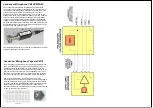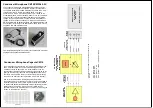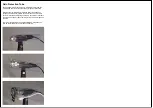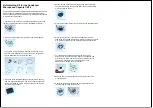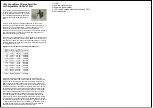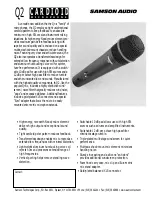
Repacing the CM16 microphone capsule
The microphone capsule consists of a thin metalized polyester film
and a metal back plate. Do not touch the diaphragm because its
metalization could be destroyed. It is recommended to use the
capsule always with the protective grid. However, depending on the
grid type, the frequency response may be degraded in some way.
Therefore, it is possible to remove or replace the grid by releasing
the nuts on the front side (use the supplied 5.5 mm box spanner).
Due to its thin metalization, the diaphragm may deteriorate
especially under humid conditions. Therefore, it is recommended to
store the microphone in a dry place. Spare capsules are available
on request and deteriorated diaphragms will be replaced by Avisoft
Bioacoustics at a small fee. With some skill, it would also be
possible to replace the membrane foil on your own (by releasing the
screws on the back of the capsule).
The condenser microphone consists of two pieces. The cylindric
preamplifier module with the 5-pole XLR connector (1 - CMPA)
is connected to the microphone capsule (2 - CM16) via a 2.5 mm
thread. This allows to replace the capsule easily. For proper
operation, both this 2.5 mm thread and the 17 mm thread on the
preamplifier module must be fastened. However, use only moderate
forces in order to prevent mechanical damages.
The integrated pre-amplifier has an internal compensation circuit
that slightly boosts frequencies above 50 kHz.
Condenser Microphone CM16/CMPA
2
1
Condenser Microphone Capsule CM16
The microphone capsule consists of a thin metalized polyester film
and a metal back plate. Do not touch the diaphragm because its
metalization could be destroyed. It is recommended to use the
capsule always with the protective grid. However, depending on the
grid type, the frequency response may be degraded in some way.
Therefore, it is possible to remove or replace the grid by releasing
the nuts on the front side (use the supplied 5.5 mm box spanner).
Due to its thin metalization, the diaphragm may deteriorate
especially under humid conditions. Therefore, it is recommended to
store the microphone in a dry place. Spare capsules are available
on request and deteriorated diaphragms will be replaced by Avisoft
Bioacoustics at a small fee. With some skill, it would also be
possible to replace the membrane foil on your own (by releasing the
screws on the back of the capsule).
The condenser microphone consists of two pieces. The cylindric
preamplifier module with the 5-pole XLR connector (1 - CMPA)
is connected to the microphone capsule (2 - CM16) via a 2.5 mm
thread. This allows to replace the capsule easily. For proper
operation, both this 2.5 mm thread and the 17 mm thread on the
preamplifier module must be fastened. However, use only moderate
forces in order to prevent mechanical damages.
The integrated pre-amplifier has an internal compensation circuit
that slightly boosts frequencies above 50 kHz.
Condenser Microphone CM16/CMPA
Condenser Microphone Capsule CM16
The microphone capsule consists of a thin metalized polyester film
and a metal back plate. Do not touch the diaphragm because its
metalization could be destroyed. It is recommended to use the
capsule always with the protective grid. However, depending on the
grid type, the frequency response may be degraded in some way.
Therefore, it is possible to remove or replace the grid by releasing
the nuts on the front side (use the supplied 5.5 mm box spanner).
Due to its thin metalization, the diaphragm may deteriorate
especially under humid conditions. Therefore, it is recommended to
store the microphone in a dry place. Spare capsules are available
on request and deteriorated diaphragms will be replaced by Avisoft
Bioacoustics at a small fee. With some skill, it would also be
possible to replace the membrane foil on your own (by releasing the
screws on the back of the capsule).
The condenser microphone consists of two pieces. The cylindric
preamplifier module with the 5-pole XLR connector (1 - CMPA)
is connected to the microphone capsule (2 - CM16) via a 2.5 mm
thread. This allows to replace the capsule easily. For proper
operation, both this 2.5 mm thread and the 17 mm thread on the
preamplifier module must be fastened. However, use only moderate
forces in order to prevent mechanical damages.
The integrated pre-amplifier has an internal compensation circuit
that slightly boosts frequencies above 50 kHz.
Condenser Microphone CM16/CMPA
2
1
2
1
Condenser Microphone Capsule CM16
Hold the preamplifier module (1) on its ribbed campling nut and turn the
CM16 capsule anticlockwise to remove it from the preamplifier module. The
protective grid can be removed by releasing the six M3 nuts. The new CM16
capsule can then be mounted in reverse order. To prevent electrostatic
dischareges that could potenmtially damage the preamplifier, one should first
briefly connect the tip of the 2.5 mm screw of the new capsule to the metal
housing of the preamolifier module before mounting it.
Repacing the CM16 microphone capsule
Repacing the CM16 microphone capsule
Hold the preamplifier module (1) on its ribbed campling nut and turn the
CM16 capsule anticlockwise to remove it from the preamplifier module. The
protective grid can be removed by releasing the six M3 nuts. The new CM16
capsule can then be mounted in reverse order. To prevent electrostatic
dischareges that could potenmtially damage the preamplifier, one should first
briefly connect the tip of the 2.5 mm screw of the new capsule to the metal
housing of the preamolifier module before mounting it.
Hold the preamplifier module (1) on its ribbed campling nut and turn the
CM16 capsule anticlockwise to remove it from the preamplifier module. The
protective grid can be removed by releasing the six M3 nuts. The new CM16
capsule can then be mounted in reverse order. To prevent electrostatic
dischareges that could potenmtially damage the preamplifier, one should first
briefly connect the tip of the 2.5 mm screw of the new capsule to the metal
housing of the preamolifier module before mounting it.



